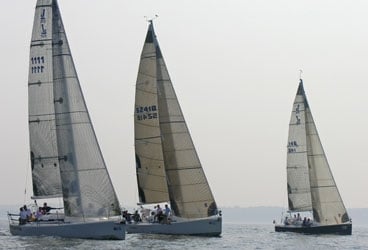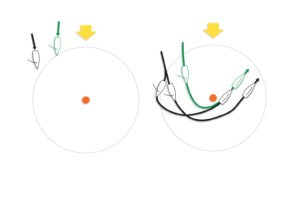
Light air 368 walker
I have always believed a competitor learns from his mistakes, but my actions in the fifth race of the 2008 Soling North Americans at Toronto demonstrate that he also forgets them. Admitting that I have made this mistake several times before damages my credibility, but the need to stop repeating it before I die seems to justify a full and public analysis. So here is a thorough confession and an opportunity for everyone to review the factors that determine success in light air and to establish an order of precedence.
On the morning of the third day of the regatta (after four of seven races) we were essentially tied with Hans Fogh for the lead, each having a 1-2-3 to count, but Peter Hall and Kevin Brown were close astern. The wind was flowing parallel to the 1- to 2-mile distant shore, looked to be stronger near shore and oscillated about 5 degrees to either side of a median of 85 degrees.
Before the start a little after noon, we decided we would treat the beat as a light-air Category 2 condition (one side obviously advantaged) and get outside, avoid the middle, and keep going in one direction until we reached the advantage. And the side we determined was most likely advantaged was the left; in light air go where the wind is (or will be) stronger and (when in doubt) go for the shore. Thermal turbulence in the overland segment of the parallel-to-shore-flow-with-water-on-its-left should (as it does at Rochester) bring down stronger upper level flow near shore. Besides, the wind looked stronger there already.
A minute before the start the port end of the line became favored in a 5-degree back to 80 degrees, which was nice, but I did not intend to play the oscillations. We were off at the pin in clear air, the entire fleet to windward and astern. Almost immediately, however, the nearest boats began to lift inside us. I had that sinking feeling that we might be about to receive that worst of all possible outcomes for a boat starting at the pin-a progressive veer. But it was just the expected oscillation, taking us back to the 85- to 90-degree wind direction we had experienced before. It produced little damage other than permitting the nearest boats to sail well above us in clear air. We settled in for the long haul.
A few boats had gone off on port and were difficult to evaluate in the haze, but we were slowly working out ahead and to leeward of Fogh and Peter Hall (on our hip astern of two others, Ken Davy and Chris Duley) and leaving Henry Thomas, who was directly astern. Halfway to the layline we presumed that, if we were to tack, we would pass close astern of Davy and Duley, but well ahead of Fogh and Hall and would be third.
At about two-thirds the way to the layline, we began to be lifted and I began to consider the defects of our position. I was the farthest left in a fluky, dying easterly. If it kept on veering, everyone would lift up to the rhumb line inside us. I began to compare the advantages of continuing with the advantages of tacking. “Cross ’em when you can” came to mind. I could get over into that line of boats 250 to 300 feet to my right, tack in front of Fogh, and be in control regardless of any subsequent shift or variation in wind velocity. I would be throwing away my strategic advantage-outside, closer to shore, on and on until an advantage was reached-but I would be in tactical control.
My psyche was on the defensive; I was no longer charging off into the north to find the best conditions on the lake. I was no longer focused on daring and winning; I was becoming concerned with security and losing. I tacked to port.
When I later described this situation to my brother (who is not a racing sailor), he immediately asked the critical question. “How soon did you realize the tack was wrong? That it was not going to provide the advantage that you expected?” And the answer is-almost immediately. I could see we were heading much lower than I had expected and that we would not cross ahead of Fogh. I now made a second and far more profound mistake. Instead of tacking back to salvage as much as possible of my initially advantageous position, I continued on port astern of both Fogh and Hall.
I had thrown away all of the advantages of the outside, nearest-to-the-shore position and had gained nothing. The wide tacking angle in the very light air, the slow speed build after tacking, the oscillating veer at the time of the tack were combining to wreck my plan. I didn’t tack back because I told myself that beyond Fogh and Hall would be a progression of the veer in which I thought I was sailing (and undoubtedly because I didn’t want to admit that the tack was wrong from its inception). Crossing astern should never be done without good reason. Is the other boat on the wrong tack? Is it heading out close to the layline? Is there an unforeseen advantage?
Except in oscillating winds, crossing the rhumb line twice is rarely wise. In (almost) all other circumstances, if you start out heading left, you should keep going left until the wind comes your way. And the intent of management in all Category 2 conditions is to continue on the selected side until the advantage is reached. We had abandoned our left corner position before any advantage had been reached.
Of course, smart sailing is always about risk aversion. Do that which is most likely to be beneficial, not what is likely to be detrimental or unlikely to be beneficial. Elvstrom says, “Always seek a position from which winning is possible, not one from which winning is impossible.” It was possible, but it was not likely, that crossing astern of Fogh would be beneficial, that the veer would progress and that we would be to his right when it did; but there were many other boats farther right who we would then be behind. On the other hand, experience indicates that in light air, continuing outside the fleet in one direction offers a 60- to 70-percent chance of reaching an advantage, and that the advantage, when it is reached-a persistent shift your way or wind when the rest of the fleet has none or very little-will be a big one.
And when I tell you what happened, you will accept my thesis. After I tacked to port, Duley and then Fogh and Hall tacked above me and to my left. Five minutes later a 20-degree back with a significant increase in velocity rolled in from the left corner. Ken Davy, who had been leading all the boats on the left, tacked to port, easily laid the mark and rounded first. Henry Thomes, who had been 200 yards dead astern when we tacked, tacked to port, laid the mark on a close reach and rounded second. As he received the spreading flow, Fogh, on our hip, lifted inside us, rounded the mark a hundred yards astern of Thomas and more than that ahead of us. We finished seventh and Fogh finished third. He later said that halfway up the beat he had told his crew, “Stu will win this one,” and was amazed-and pleased-to see us tack.
One race proves little, but many races prove that in light air one must avoid the middle, get outside and keep going until an advantage is reached. The maxim will not always work, but to flout it is to risk disaster for little possibility of gain. Winning always takes courage and hubris, the belief that you are wiser than others, but never more so than in light air.
And strategy trumps tactics. “Cross ’em when you can” and “keep closer to the rhumb line than your opponent” are correct in moderate air and when there is no obvious advantage ahead, but in light air, they only please your competitors.
Light-air Priorities
1. Recognize that in light air one side of the course is advantaged. A stronger wind will develop eventually and it will do so on one periphery of the course or the other.
2. Select the side you believe will be advantaged. Start at the end of the line nearest that side and head that way.
3. Keep going until a localized increase in velocity, a shift your way, or some other advantage appears. Do not tack until it does.
4. Stick to your plan. Do not tack for tactical reasons. Have the courage of your convictions.
5. You may be right 60 to 70 percent of the time, but when you are right, you will win. When you “chicken out” early, you will eliminate all chance of winning.









